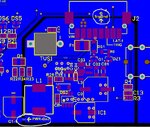rocky79
Member level 5
I have a DC-DC switching regulator that operates at switching frequency of 260Khz. It steps down a 28vdc to 3.3Vdc.
On the same PCB I have a microcontroller and would like to have it's ground plane to be as clean as it can be from any switching regulator noise .
Will a ground moat around the switching regulator helps in this case? I will have a 50mil trace that connects the switching regulator ground to the microcontroller ground. Your feedback is appreciated.
Thanks!

On the same PCB I have a microcontroller and would like to have it's ground plane to be as clean as it can be from any switching regulator noise .
Will a ground moat around the switching regulator helps in this case? I will have a 50mil trace that connects the switching regulator ground to the microcontroller ground. Your feedback is appreciated.
Thanks!
